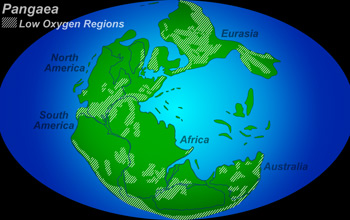All Images
News Release 05-058
Reduced Oxygen Contributed To “Great Dying”
Oxygen deficiency could also account for the delayed recovery of species diversity
This material is available primarily for archival purposes. Telephone numbers or other contact information may be out of date; please see current contact information at media contacts.

A depiction of the supercontinent Pangaea some 250 million years ago shows regions where oxygen was insufficient for animal survival. Because oxygen levels decrease with increasing altitude, the more mountainous "hatched" areas would have prevented intermingling and reproduction between nearby animal populations.
Credit: Nicolle Rager, National Science Foundation, based on
Pangaea map data, Paleogeographic Atlas Project, University of Chicago
Download the high-resolution JPG version of the image. (289 KB)
Use your mouse to right-click (Mac users may need to Ctrl-click) the link above and choose the option that will save the file or target to your computer.

The red line shows atmospheric oxygen amounts over time. The black line indicates the altitude in today's atmosphere where that amount of oxygen is found. When oxygen levels were at their lowest around 240 million years ago, an animal living at sea level would have experienced oxygen availability similar to that today at 17,400 feet.
Credit: Nicolle Rager, National Science Foundation, based on
data from Robert Berner, Yale University, and from Raymond Huey and Peter Ward, University of Washington
Download the high-resolution JPG version of the image. (187 KB)
Use your mouse to right-click (Mac users may need to Ctrl-click) the link above and choose the option that will save the file or target to your computer.
